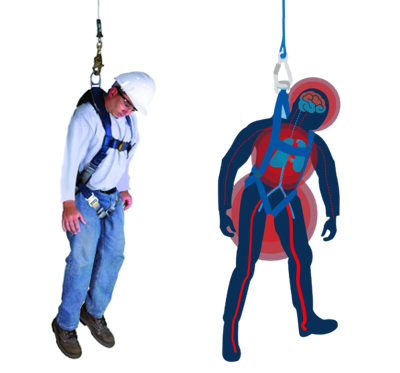If the employee remains suspended in case of a possible fall while working at height, the person will remain motionless and in an upright position for a long time. As a result of the seat belt putting pressure on the person’s body, he or she will enter a process known as suspension trauma, which may even lead to loss of life.
In this article, the chemistry and physiology of suspension trauma and ways to avoid danger before, during and after the victim is lowered to the ground will be explained. For occupational health and safety professionals and those writing work at height and rescue plans, it is important to understand this information so that the hazard can be reduced and the rescue can be appropriately planned. For emergency medical personnel responding to the rescue of a suspended worker, knowing the physiology behind suspension trauma is key to providing appropriate treatment to the casualty.
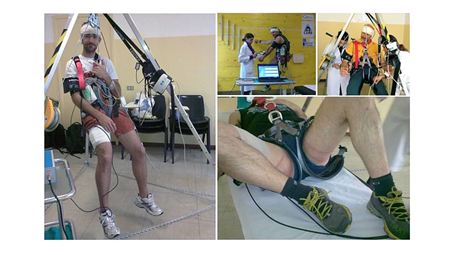 There is an ongoing debate in the working at height industry regarding the level of risk from suspension trauma. While there is limited scientific research focusing directly on suspension trauma, there is enough information about the body’s physiology to show that this condition can be fatal.
There is an ongoing debate in the working at height industry regarding the level of risk from suspension trauma. While there is limited scientific research focusing directly on suspension trauma, there is enough information about the body’s physiology to show that this condition can be fatal.
What is Suspension Trauma?
Suspension trauma, known as orthostatic shock, seat belt suspension syndrome or orthostatic intolerance, occurs when the human body is kept upright without movement for a long time. This can lead to fatigue, hypoglycemia, hypothermia, and in extreme cases, traumatic brain injuries.
If working at heights is a regular part of your job, using appropriate fall protection equipment is essential when it comes to getting the job done efficiently and safely. The danger is not over after the employee falls and is caught by the seat belt. In some cases, the employee may be at risk of a life-threatening emergency. If the falling worker’s blood circulation is restricted, it causes a condition known as suspension trauma.
How Does Suspension Trauma Occur?
The fall arrest system consists of a safety belt and equipment such as a lanyard that connects the worker to the anchor point. In this system, the energy of the fall is absorbed by the lanyard (or other fall arrest equipment) and the worker is prevented from hitting the ground. Meanwhile, the employee remains suspended on the seat belt attached to the lanyard after the fall is stopped. The leg columns of the seat belt have to bear the entire weight of the body. During this time, the leg columns of the belt crush the femoral arteries on the inside of the legs, cutting off blood circulation. Thus, during the suspension period, suspension trauma, which is the most sensitive danger in the fall arrest system, begins to occur.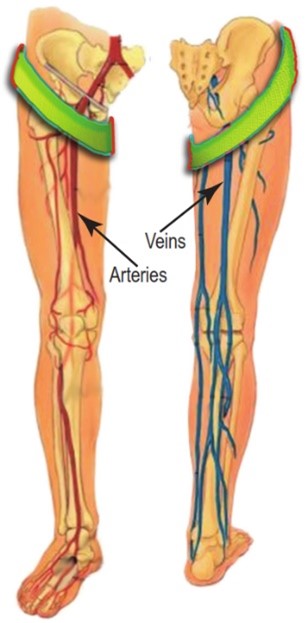
Additionally, when the leg muscles relax, the veins in the legs can dilate significantly (known as vasodilation). Since the leg muscles are not used to stand up, they do not contract and therefore do not prevent the vessels from dilating. This lack of constriction in the leg muscles allows blood to pool in the legs instead of returning to the heart and lungs for recirculation, an effect known as venous pooling. Without the restriction of the leg muscles, dilation of the blood vessels in the legs can result in a 20 percent loss of blood circulation.
Loss of circulation causes the heart to work harder to supply the brain and vital organs with blood. This causes nausea, loss of consciousness, and a drop in blood pressure and heart rate. This part of the suspension trauma is the beginning of circulatory shock.
Symptoms of suspension trauma
- Pallor
- To sweat
- Shortness of breath
- Blurred vision
- Dizziness
- Nausea
- Hypertension
- Numbness of the legs
- Syncope
- Death (lack of oxygen to the brain)
Key Factors of Suspension Trauma
The term ‘syncope’ is also commonly used when this type of accident occurs, as it is a result of loss of consciousness caused by being suspended by the legs in an immobile and vertical position rather than physical injury. Causes of syncope can be classified variously as vascular, cardiac, neurological and metabolic. Once a person becomes symptomatic, several symptoms may begin to appear, including;
- Dizziness
- Nausea
- Tingling/numbness in arms and legs
- Syncope
- Feeling flushed
These symptoms are often called ‘presyncope’ and if nothing is done to help the person who is suspended, they will eventually progress to a syncope state. However, suspension trauma does not occur as a result of a single factor; it is usually caused by a combination of factors. However, it usually occurs due to too much blood flowing to the legs and then becoming trapped, also known as ‘blood pooling’, resulting in the brain not receiving enough oxygen. Because the human body is not designed to be in an upright position for long periods of time, it does not have the ability to “suck” blood from our legs when gravity pulls it down. To counteract this, the body uses four main methods that involve pumping veins and muscles to return blood to the heart and other parts of the body. There are a number of contributing factors that lead to suspension trauma, which seriously impairs these methods of returning blood from the legs to the heart and therefore affects the amount of oxygen the brain receives. These are:
- Body weight in the seat belt compressing the veins:The compressed veins , cause the blood to not be able to go back to the heart and therefore get “stuck” in your legs.
- 2. Lack of movement: Because it restricts the body’s movement, the muscles cannot perform as they need to pump blood back to the heart.
- 3.of toxins in the blood Accumulation:Due to accumulation of blood in the legs, there is a lack of oxygen in the body, causing organs and muscles to release toxic waste products at dangerous concentration levels for survival.
Effects of Suspension Trauma on the Person Who Experienced a Fall:
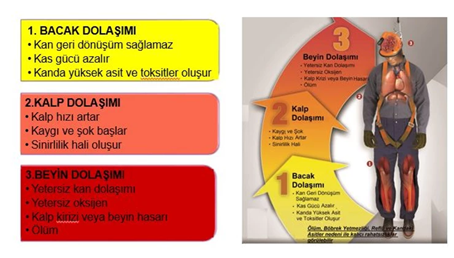
Leg Circulation:
As a result of the seat belt tightening the legs and remaining motionless, the blood in the legs will not be recycled. This will cause less blood circulation in the brain, heart, lungs and kidneys. In addition, the blood accumulated in the legs will become highly acidic and toxic with metabolic wastes.
Heart Circulation:
Since the blood in the legs cannot recycle, the heart will increase its speed and power to balance the body. This will cause anxiety and shock, resulting in the secretion of adrenaline. In this case, the demands on the heart increase and may cause the heart to stop suddenly
Brain Circulation:
Serious damage will occur due to insufficient blood circulation in the brain as a result of slowing down of blood circulation or stopping of the heart.
Body Chemistry of Suspension Trauma
When blood pools and becomes trapped in an extremity, the blood can no longer deliver oxygen from the lungs. To continue producing energy to sustain life, cells in the limb engage in anaerobic respiration (without oxygen). During anaerobic respiration, glucose (blood sugar, C 6 H 12 O 6 ) splits in half and turns into lactic acid (C 3 H 6 O 3 ) in a process known as lactic acidosis (see figure).
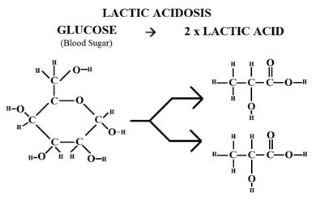
When there is no blood circulation in the legs, lactic acid accumulates in stagnant blood. This acid blood buildup is released when the worker is put down and circulation is restored. High levels of acid flooding the body can overwhelm the kidneys, liver, and even cause heart failure.
Result of suspension trauma
Beyin, kan birikmesi gibi bir sorun tespit ettiğinde, kalbin ve nefesin ritmini değiştirme yeteneğine sahiptir. Buradaki tek sorun, beynin kan havuzlaması ile kan kaybı arasındaki farkı söyleyememesi, dolayısıyla tepki verme şekli aynı. Kan bacaklarda birikmeye başladığında, beyin kanamanız olduğunu düşünerek vücudun nefes alıp verme hızını ve nabzını artırır, bu da bacaklara daha fazla kan gitmesine neden olur. Beyin, bacaklarda artan kan seviyeleri ile kendi kaynağının düştüğünü fark edecek ve sizi düşürüp bayıltmak için acil bir son çare harekete geçirecek. Böylece kan vücutta dolaşabilecek ve beyne dönüş sağlayabilecek. Fakat bir emniyet kemeri takılı ve asılı halde iken düşemezsiniz ve bu nedenle dik dururken bilinçsiz hale gelirsiniz. Bu durum sizi tehlikeye sokar. Birincisi, solunum yolunuz bu pozisyonda güvenli değildir ve durumunuz boğulmaya neden olabilir. İkincisi, beyninizde hala yetersiz oksijen var ve artık daha fazlasını almanın da yolu yok. Vücudunuzun artık bir yedek planı da yoktur.
Rescue on a suspension trauma
- Tüm kazalarda olduğu gibi, önleme, tedaviden daha iyidir.
- Çalışan emniyet kemerinde asılı kalmışsa ve hala bilinci açıksa, üzerinde duracak bir şeyin olması yararlıdır. Çünkü ona karşı iterek bacak kaslarını kullanmalarına izin verecektir. Bunu yapmak kanın gövdeye geri dönmesini sağlar. Bacaklarını havada hareket ettirmeleri tavsiye edilmez. Bu, kanın bacaklardan gövdeye doğru hareket etmesini sağlamasına rağmen, sonunda kişi yorulursa, bacaklar kanı biriktirmeye başlayacaktır.
- OSHA Düşme Koruması standardı 1926.502 (d) (20), düşme durumunda çalışanların “derhal kurtarılmasını” gerektirir. Bir kişi ne kadar uzun süre askıda kalırsa, semptomların ve diğer etkilerin ortaya çıkma ihtimali o kadar artar. Kazazede kurtarıldığında durumu rahatlar, bu nedenle kişi mümkün olduğunca hızlı bir şekilde dik bir pozisyondan çıkarılmalıdır, özellikle de hareketsiz durumdaysa.
- Kurtarıcılar, kazazedenin çok hızlı bir şekilde yatay konuma getirilmesi durumunda kurtarma sonrası ölüm olabileceğinin farkında olmalıdır. Askıdan alınan işçi bilincini kaybetmiş olsun ya da olmasın, kurtarma ekibi kazazedeyle ilgilenirken dikkatli olmalıdır. Kurtarma sonrası ölüm, bacaklarda aniden artan karbon dioksit doymuş kan akışını kalbin tolere edememesinden kaynaklanır. Kurtarılmış bir işçiyi bilinçli olsun ya da olmasın yatay pozisyona almayın.
- Kurtarıldıktan sonra kişi bilinçliyse, kan dolaşımını hızlandırmak ve kan basıncını düşürmek için bacaklarına nazikçe egzersiz yapılmalıdır.
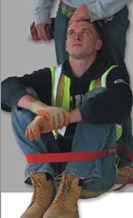 Uzun süre askıda kaldıktan sonra kişi kurtarıldığında, düşme nedeniyle herhangi bir görünür yaralanması yoksa en az 30 dakika “W” pozisyonunda oturmalıdır. Bu pozisyon, kişinin yere dik oturduğu ve dizlerini çenesiyle aynı hizada tutarak bacaklarının bükülü olduğu pozisyondur. Bu şekilde oturarak, biriken kanın bacaklardan akmasına ve vücuda yavaşça yeniden girmesine izin verir ve yeniden akış sendromunu önler. Bu, vücudunuzun birikmiş kanı daha iyi filtrelemesine yardımcı olur. Oksijenden yoksun kanın aniden kalbe geri dönmesini önlemek için en az 30 dakika bu pozisyonda kalmalıdır.
Uzun süre askıda kaldıktan sonra kişi kurtarıldığında, düşme nedeniyle herhangi bir görünür yaralanması yoksa en az 30 dakika “W” pozisyonunda oturmalıdır. Bu pozisyon, kişinin yere dik oturduğu ve dizlerini çenesiyle aynı hizada tutarak bacaklarının bükülü olduğu pozisyondur. Bu şekilde oturarak, biriken kanın bacaklardan akmasına ve vücuda yavaşça yeniden girmesine izin verir ve yeniden akış sendromunu önler. Bu, vücudunuzun birikmiş kanı daha iyi filtrelemesine yardımcı olur. Oksijenden yoksun kanın aniden kalbe geri dönmesini önlemek için en az 30 dakika bu pozisyonda kalmalıdır.- Kişi bilinçli değilse, ayaklarının hafifçe kaldırılması gerekir.
- Kurtarıcılar, askıya alma travmasını önlemek için ilk yardım önlemlerinden haberdar olmalıdır.
- Kişinin durumu veya askıya alma süresi hakkında herhangi bir olağanüstü durum varsa, derhal sağlık kurumları uyarılmalıdır.
How Can You Prevent Suspension Trauma?
Although complications from suspension trauma are serious, dealing with suspension trauma is not seriously complicated.
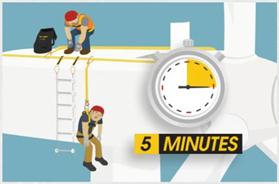 | Rescue Plan: |
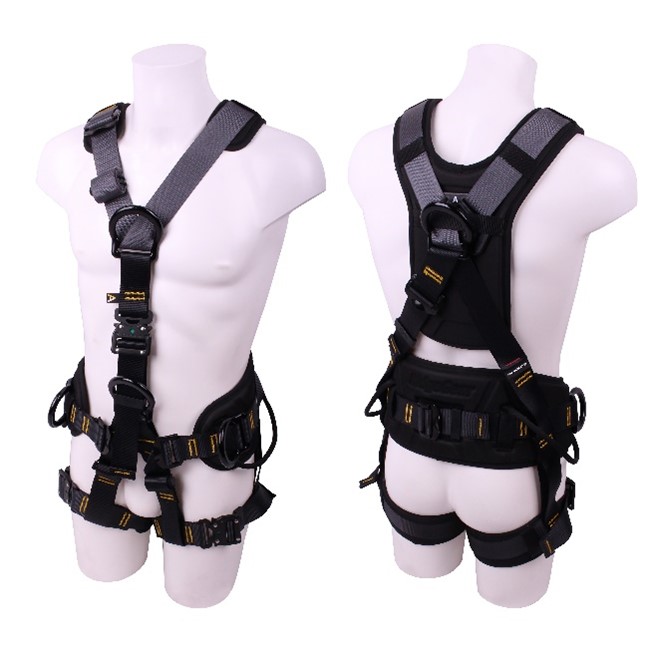 |
Proper belt selection: The type of seat belt without leg pads, which restrict movement and tighten the legs while hanging, can cause symptoms to appear much more quickly. Belts should be chosen by taking into account the design suitable for every job, ease of use and suspension trauma. |
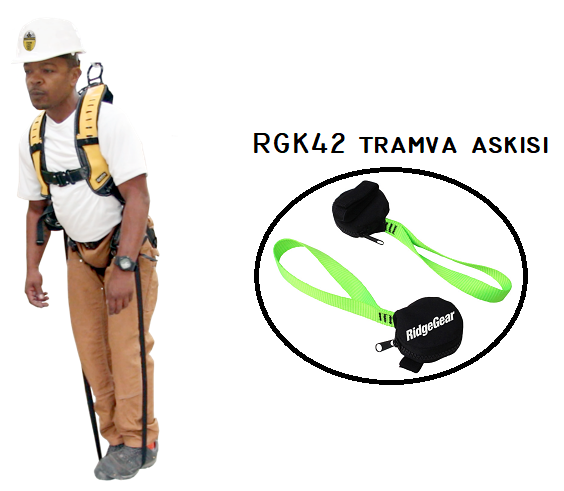 | Possible rescue equipment: Keeping a suspension trauma sling on their seatbelt and using it when necessary will help the suspended worker to stand up and safely prolong the suspension, allowing them to use their leg muscles, take weight off their arteries, and restore blood circulation until help arrives. Many fall arrest equipment manufacturers produce suspension trolley hangers with seat belts as standard. RGK42 Trauma Hanger:https://pirisafe.com/pro_yatay_yasam_hatti_PLINEH1.html |
| Working alone: Working at heights should be done with a minimum of two people. After a fall, you may not always have the chance to survive on your own or to communicate your situation to someone to get help. | |
Conclusion,
In a technical bulletin on suspension trauma, OSHA determined that suspension trauma can be fatal within 30 minutes of the initial fall. This 30minute window is what OSHA means when it says a fall protection plan should include plans for a “rapid” rescue. It is also important for rescuers and those writing fall protection plans to understand the hazards present, such as the effect of lactic acid building up in the suspended worker’s legs after being lowered.
Suspension trauma poses a serious risk for those working at height. The physiological response to the known symptoms of suspension trauma confirms that this danger can be fatal. However, for all work done at height that involves a rescue plan, seat belts should include a suspension tram hanger set, and training on the dangers within the scope of use are simple steps that can be taken to reduce the danger of suspension trauma.
By knowing more about what suspension trauma is and how it affects the body, we can better plan for hazards and continue to improve the safety of our work.
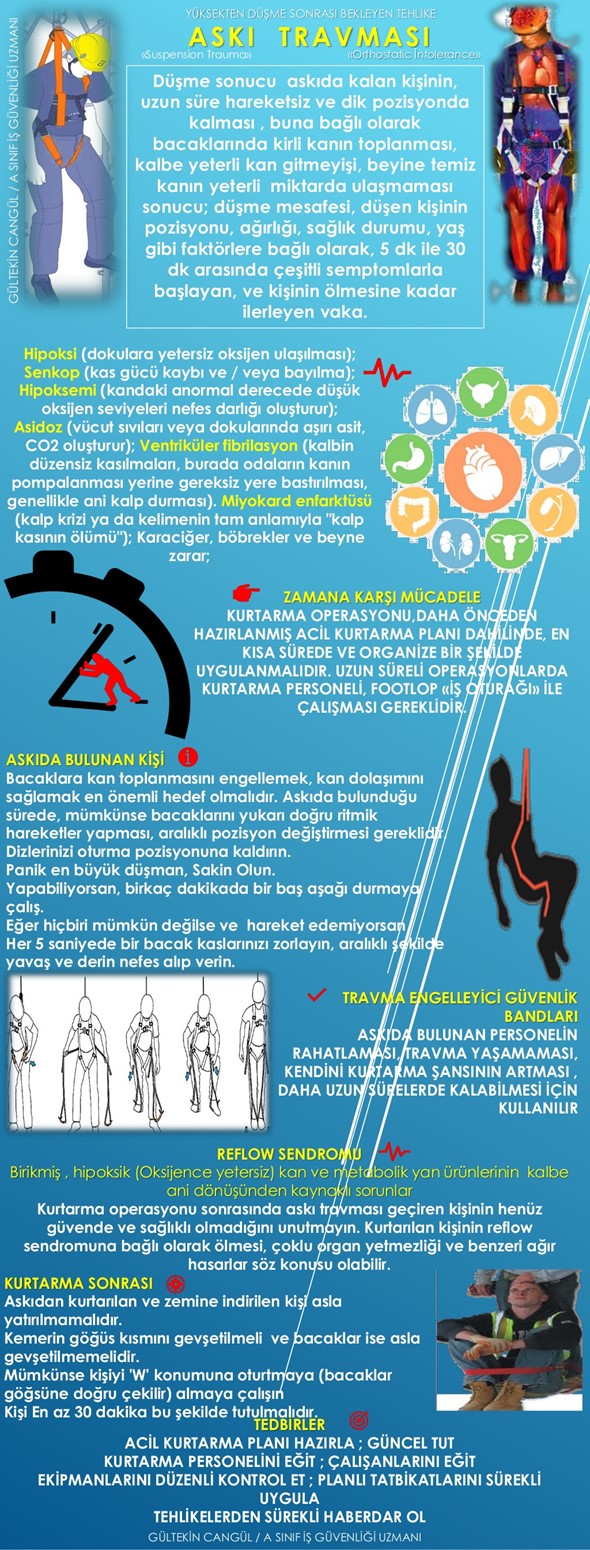
Kaynak:
1.) https://www.hallmark.com.tr/post/ask%C4%B1-travmas%C4%B1-suspension-trauma
2.)Other resources…
Tramva Askımız:
RGK42 Travma Askısı:https://pirisafe.com/urun/travma-askisi/

 Türkçe
Türkçe
